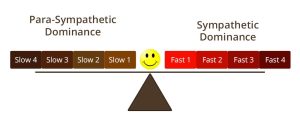Nine Most Important Rules In HTMA Mineral Balancing by Dr. Paul Eck
Mineral balancing using HTMA involves complicated relationships between various minerals and metals
that have to be balanced in the actual amounts for each and also in the ratios between important minerals.

#1 – A high mineral level can be just as damaging as a low mineral level.
In other words, a person with a very high calcium level can be just as bad off as if he had a very low calcium level. In both conditions, the body cannot properly utilize calcium.
#2 – Mineral levels are not always as they appear.
Just because a mineral “appears” to be at its normal level, doesn’t mean that it really is. For example, the normal level of copper is 2.5.
For example, if your copper level is normal on the hair test, you may still be low or high in copper. You might have major mineral imbalances or stress in your body which is causing the copper to “appear” normal.
In a later hair test your copper may end up being off the chart on the high end. You have to be like a detective in reading a mineral chart.
#3 – Just because a level is low, it is unlikely to rise due to supplementing it.
Giving a specific mineral which appears to be “low” on a chart will rarely – if ever, raise that particular mineral level.
For example, if a person has a low manganese level on his chart, giving that person manganese will rarely raise his manganese level.
#4 – The longer a ratio is out of balance, the longer it will take to correct the imbalance.
This means that if you have been a very slow oxidizer for ten or fifteen years, don’t expect to become a normal oxidizer overnight.
#5 – It’s easier to slow a fast oxidizer down, than it is to speed a slow oxidizer up.
Stated another way, it is easier to walk downhill than it is to walk uphill.
#6 – Certain minerals tend to go out of balance in combination with other minerals to maintain a homeostatic ratios as constant as possible.
In many cases, when one mineral level rises, a second mineral level will also rise, to stay in balance with the first mineral level.
For example, when the calcium levels rise in a person, the magnesium level will also rise. Because of this elevated magnesium level, the ratio between the calcium and the magnesium will stay relatively constant.
#7 – On a Mineral Balancing Program, mineral ratios improve first, before specific minerals levels improve.
This is why many levels will appear to get worse on a person’s chart when he goes on my program. Because of this, many people think that I don’t know what I am doing. A person’s calcium or sodium level may even decrease below normal when he goes on my program. But if you look at his chart closely, another major mineral ratio probably vastly Improved. This happens all the time. Remember, mineral ratios generally improve first. When they are balanced, then the levels will come into balance.
#8 – A given mineral can either raise or lower another mineral.
For example, depending on a person’s biochemistry, a certain mineral may raise another in the body. And, at a different time, this same mineral may lower that other mineral.
#9 – The further a mineral deviates from the normal range the less energy a person will have.
This is true, regardless of how good a person’s ratios appear to be.

